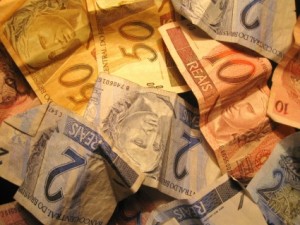
The cost of living is rising in Brazil. Photo © Michael Sommers.
I don’t need to read an article to tell me how expensive Brazil has become – especially, for those who come bearing American dollars. Having lived in Brazil for 12 years now – and earned the major part of my livelihood in greenbacks, I’m painfully conscious of the fact that since 2003, the value of Brazilian real has increased 122 percent against the once mighty dollar. I’m also pretty aware – as are most of my Brazilian friends – that many things (bus fare, beer, life in general) – are slowly, but surely, getting more expensive.That said, it took reading an article published on Bloomberg.com to hit home just how much the real has actually risen and costs have been creeping up due to inflation. Brasília-based reporter Andre Soliani’s point of departure is the fact that it’s now cheaper to stuff oneself on Brazil’s famous barbecue at one of the burgeoning number of Fogo de Chão churrascarias in the U.S. than at the upscale restaurant chain’s Brazilian counterparts.
The Brazilian government has attempted to check both rising costs and the rising real, but so far efforts have been in vain.The article goes on to point out a wide range of consequences to Brazil’s astronomic economic growth and the attendant “currency war” that the country appears to be losing; as the real continues to soar against the dollar and other international monies, it has become, in the words of Goldman Sachs, “the world’s most overvalued currency.” Among the most striking results is the fact that the cost of living in Rio de Janeiro, São Paulo, and Brasília is now higher than any U.S. city including New York, according to London-based human resource company, ECA International.The Brazilian government has attempted to check both rising costs and the rising real, but so far efforts have been in vain. The inflation is a consequence of decreasing poverty, increased purchasing power (particularly among Brazil’s vast emerging middle class), and record-low unemployment, all of which are propelling an unprecedented shopping spree among Brazilians with money to burn.
Meanwhile, seduced by the economy’s robustness and stability, not to mention some of the highest interest rates on the planet, foreign investors have been pouring their capital into Brazil at such rates – $45.9 billion so far this year – that the government has tried to actually dampen enthusiasm (and the real’s gains) by imposing taxes on capital inflows and foreign loans.
As I noted in an earlier post – in which I described how Brazil’s booming economy influenced many of the changes I made for the soon-to-be-coming 3rd edition of Moon Brazil – this means that Brazil is no longer the budget paradise that it once was for foreign travelers. However, it doesn’t mean that traveling cheaply in Brazil is impossible; it’s just more of a challenge.
By doing a modicum of research, making careful choices, getting out of the major cities (or their swankiest neighborhoods), and living, and spending, like the locals (just not the wealthier ones), you can still live it up for less than it would cost in most parts of North America and Europe – especially if you steer clear of McDonald’s.
Yes, unlike North America where a meal under the Golden Arches is still a good deal, it’s a sign of the times that in Brazil – according to data compiled by Bloomberg from The Economist’s Big Mac index– the iconic burger (which in 2010 sold for $5.26 in Brazil compared with $3.71 in the U.S.) is the fourth most expensive in the world! Better to do like Bahians and stick to acarajés.